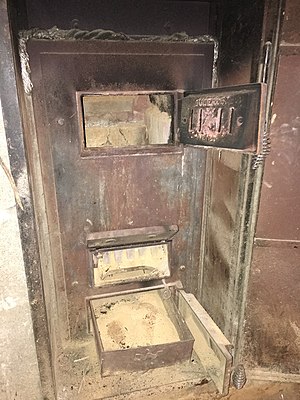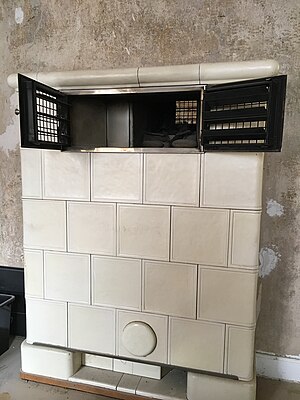Warm air heating
A hot air heating is a heater which keeps the heat without intermediate carrier and distributed in a building as warm air. The heat carrier is air, which in small systems is moved as warm air using gravity circulation (warm air is lighter and rises - cold air is heavier and sinks), in larger systems with the help of fans .
Heat sources
The air can either be heated in an oven or electrically (in a fan heater ) or collected in a solar air collector . When burning heating material, the circulating room air must be heated using a heat exchanger. If floors or walls are heated directly by the exhaust air from the combustion, it must be ensured that the exhaust gases do not get into the room air. With modern room ventilation technology , fresh air supplied can be heated by recovering heat from the room exhaust air.
The heated room air is fed directly into the room to be heated. A safety temperature limiter can ensure that the system interrupts heating if the temperature is too high. The room air is mixed via adjustable supply air, exhaust air and outside air flaps in such a way that it corresponds to the current requirements in terms of heat quantity and air quality.
history
During an archaeological excavation in the area of the Kaiserpfalz Ingelheim in 1997, a warm air heating of the 12th / 13th Century. The heating system was found south of the throne hall (Aula regia). In addition to references to facilities in the Kaiserpfalz Goslar (ground floor of the hall building, around 1180), Dankwarderode Castle in Braunschweig (ground floor of the hall building, around 1160/70) and Neuchâtel over Freyburg (13th century), it is one of the oldest to date Evidence of such a heating system is. During archaeological excavations at Sulzbach Castle in the Upper Palatinate, remains of several air heaters from the 9th to 12th century were uncovered, which were constructed differently, but their connecting element was the location under the floor of the to warming room. Presumably, the heating type was preferred in Central Europe for the functional room type of the Dürnitz (also: Hofstube), a ground-level, hall-like common room on castles.
The technical structure of the hot air heating in the Ingelheim example is divided into the functional areas of the combustion chamber, furnace jacket and hot air ducts. The combustion chamber was supplied with fuel through an opening from the south side, emptied and cleaned. The anchoring holes of an iron stove flap are still visible in the sandstone walls of the opening. The oven walls consisted of cup tiles that were layered in clay at close intervals. This type of construction is reminiscent of the tiled stoves that can be found on some illustrations from the late Middle Ages. The dating of the furnace around 1200 is based on the shape and type of goods of these mug tiles. The furnace jacket was sealed with clay and enclosed the furnace on three sides. The fourth wall formed the apse of the Aula regia. This design made it possible to store the heat from the furnace, even long after the end of the firing process. It could then be conducted smoke-free through openings or ducts into a living room above the stove.
Since the Ingelheim hot-air heating system is a unique, technical and historical monument in terms of shape, size and state of preservation, it was permanently preserved and made accessible in 2000 by a protective building.
Warm air heating systems were installed in central European palace buildings up to the 15th century, including on the upper floors, which was particularly complex. Traces from the time around 1380 have been preserved in the castles of Rochlitz and Mildenstein Castle . In the 15th century, Marburg Castle also had an elaborate warm air heating system on the first floor of the south wing.
A much more recent, historical hot air heating system can still be seen in working order in Villa Hügel in Essen . Krupp himself designed these for his home, but the difference to today's systems is enormous. For example, a shaft several hundred meters long is responsible for the supply of fresh air to a room, which takes on the function of the heat exchanger .
The air ducts used to be made of Eternit panels . Today air ducts, which are mostly made of galvanized sheet steel and have a rectangular or round cross-section (spiral duct), are used.
Since air, in contrast to water, stores heat very poorly, warm air heating in residential buildings is only suitable for small heat outputs (e.g. holiday bungalows) and rarely used rooms. Accordingly, it is considered in low-energy houses if heating outputs of up to 10 W / m² are sufficient. In Central and Northern Europe, with its comparatively cold winters, warm air heating is only suitable to a limited extent , but this type of heating has spread in the USA , especially in the southern states.
- advantages
- Fast heat-up time
- Mixing of fresh air possible
- Circulating air can be filtered
- No radiators
- Duct system if needed for air conditioning available
- disadvantage
- Odors are quickly spread across all rooms
- Noise can be transmitted through the channels
- Dust can be whirled up, carried away and distributed
- the relative humidity can drop sharply
See also
- Hypocaust (ancient warm air heating)
literature
- Klaus Bingenheimer: The air heaters of the Middle Ages. On the typology and development of a technological-historical phenomenon . Hamburg 1998
- Gunnar Möller: Medieval air heating in Stralsund - new findings . In: Brüggemann, Stefanie (Ed.): Cellars in the Middle Ages and Modern Times. Contributions to archeology, building history and history. Report on the “Cellar Cadastre” conference of the Lower Monument Protection Authority of the Hanseatic City of Stralsund in Stralsund, October 21-22, 2005. Langenweissbach 2006, pp. 45–58
- Rüdiger Schniek: Medieval warm air heating systems in Northern Germany and Denmark. Supplementary remarks on the latest research . In: Offa, 56 (1999), pp. 171-181.
- Diethard Meyer: Warm air heating systems of the Middle Ages. Findings from Lübeck in a European comparison . In: Lübecker Schriften zur Archäologie und Kulturgeschichte, 16 (1989), pp. 209–227.
- Mathias Hensch : Sulzbach Castle in the Upper Palatinate. Archaeological-historical research on the development of a rulership center from the 8th to 14th centuries in Northern Bavaria . 3 vol., Büchenbach 2005, here vol. 1, p. 193ff (Chapter 11.7. Cultural, historical and technological interpretation of heating systems).
- Stephan Hoppe : court room and table room. Functional spatial differentiation in Central European aristocratic seats since the High Middle Ages , in: Großmann, Georg Ulrich; Ottomeyer, Hans (ed.): The castle. Scientific companion volume to the exhibitions "Castle and Lordship" and "Castle Myth". Publication of the contributions to the symposium “Die Burg” from March 19-22, 2009. Berlin / Nürnberg / Dresden 2010, pp. 196–207 ( full text online ).
Web links
- Excavation information is under 1997: Karolingerstraße
- Determine heat requirement for halls and large rooms
- Design heat exchanger, calculate ventilation heat loss
- A 14th century warm air heater at Dollnstein Castle
- Warm air heating system
Individual evidence
- ↑ Cf. Mathias Hensch : Sulzbach Castle in the Upper Palatinate. Archaeological-historical research on the development of a rulership center from the 8th to 14th centuries in Northern Bavaria. 3 vol., Büchenbach 2005, here vol. 1, p. 193ff.








